
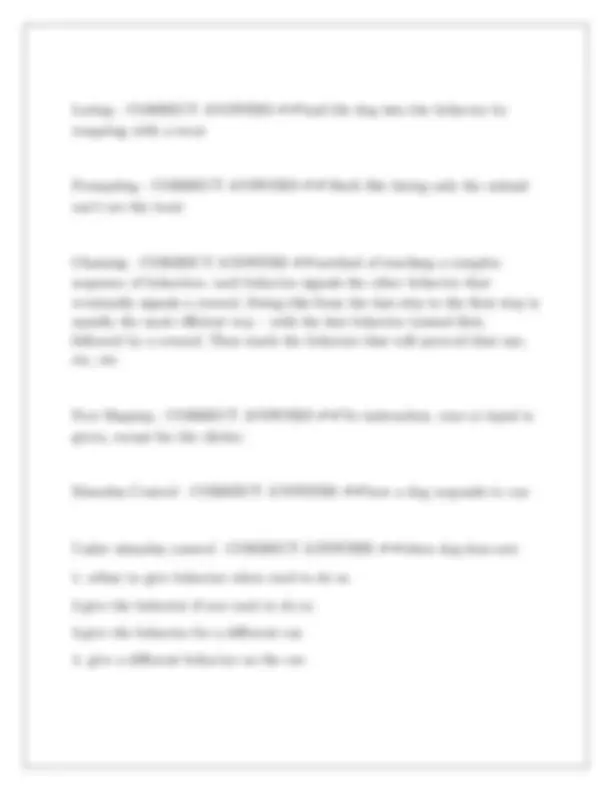
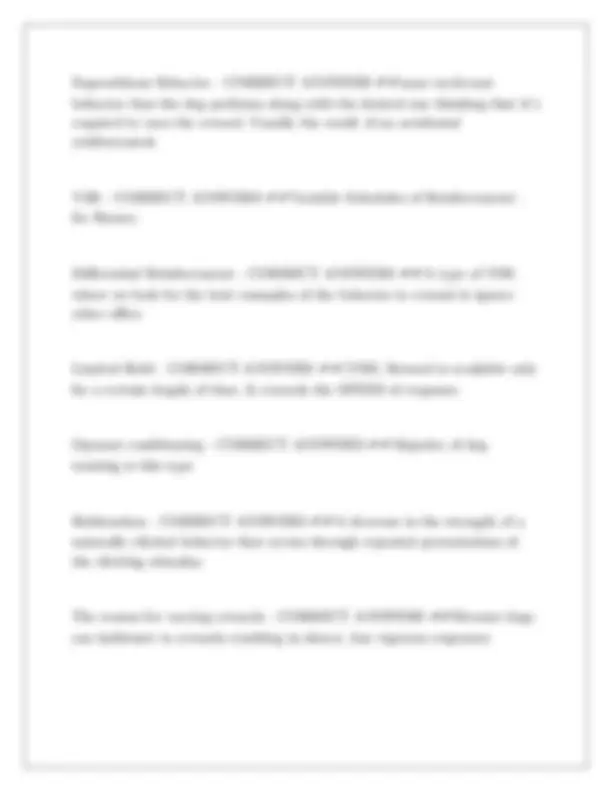

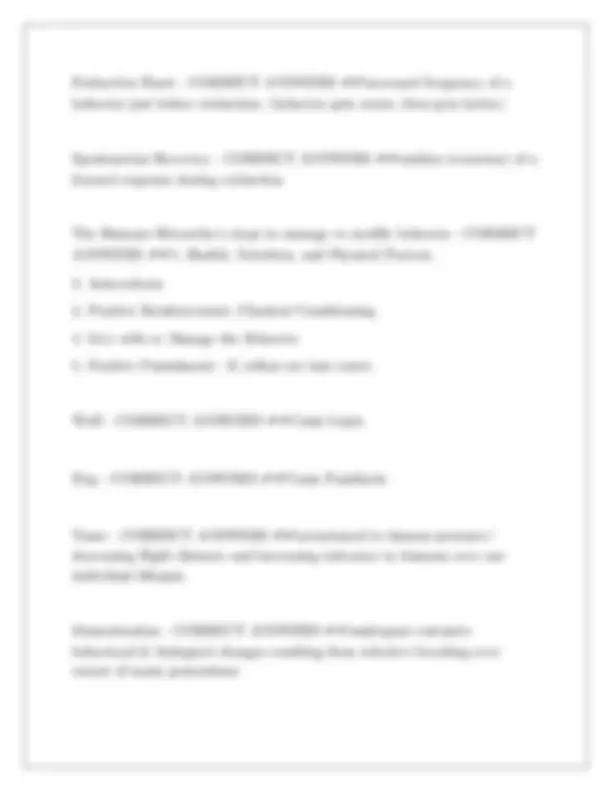
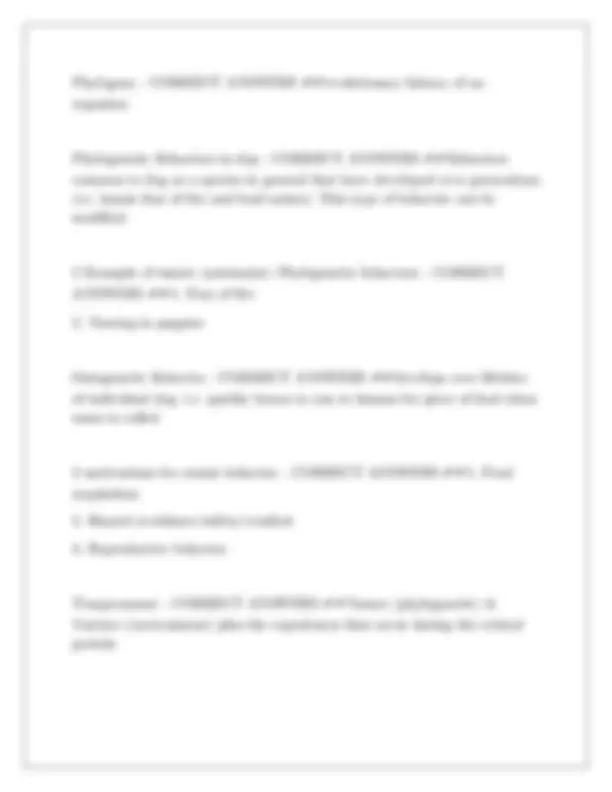
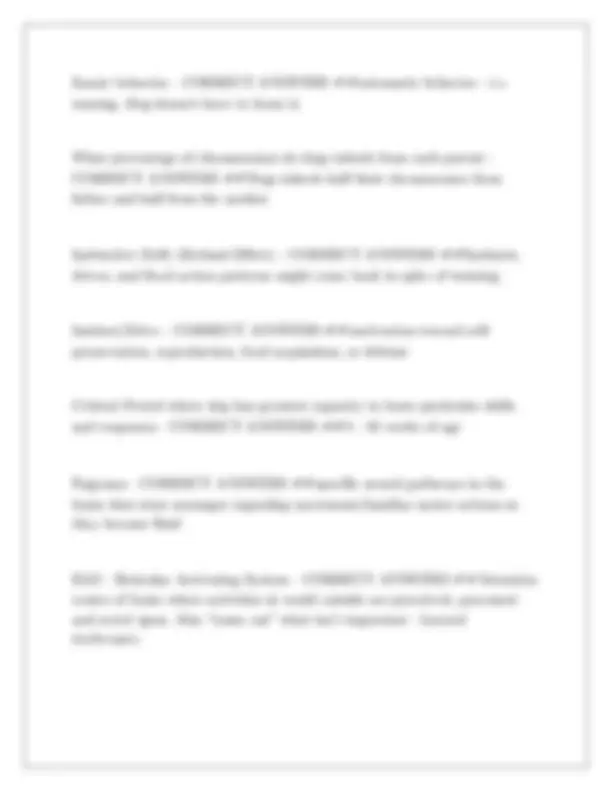
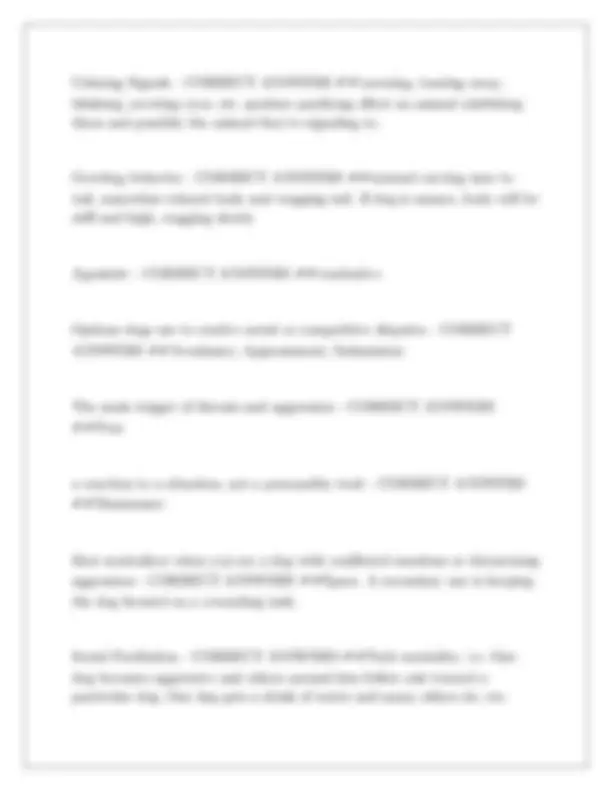
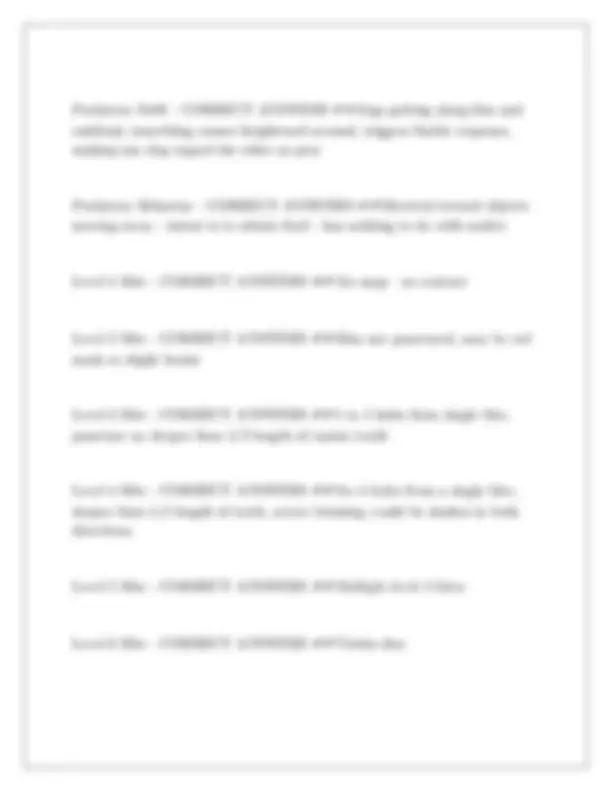
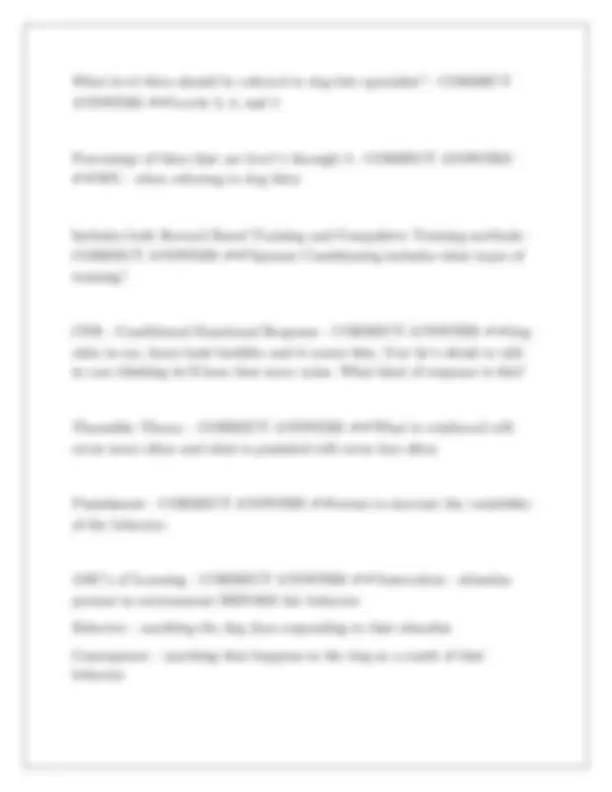
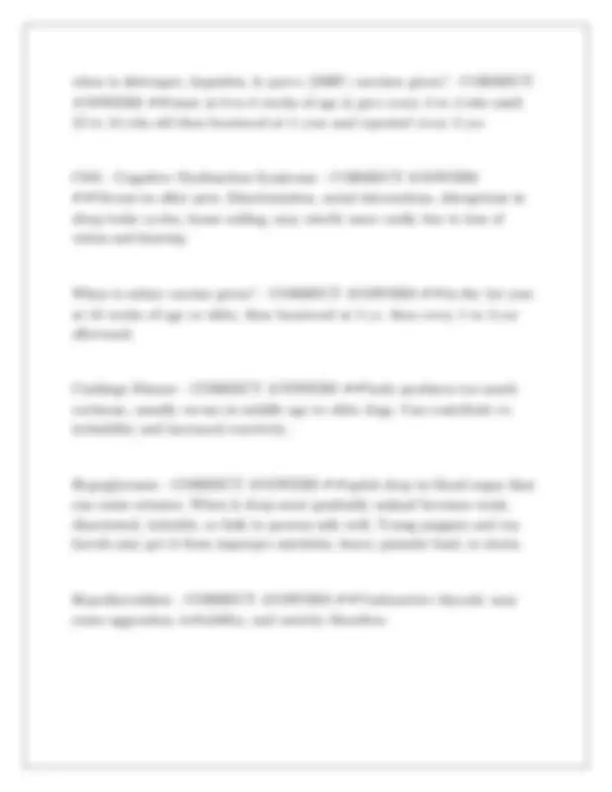
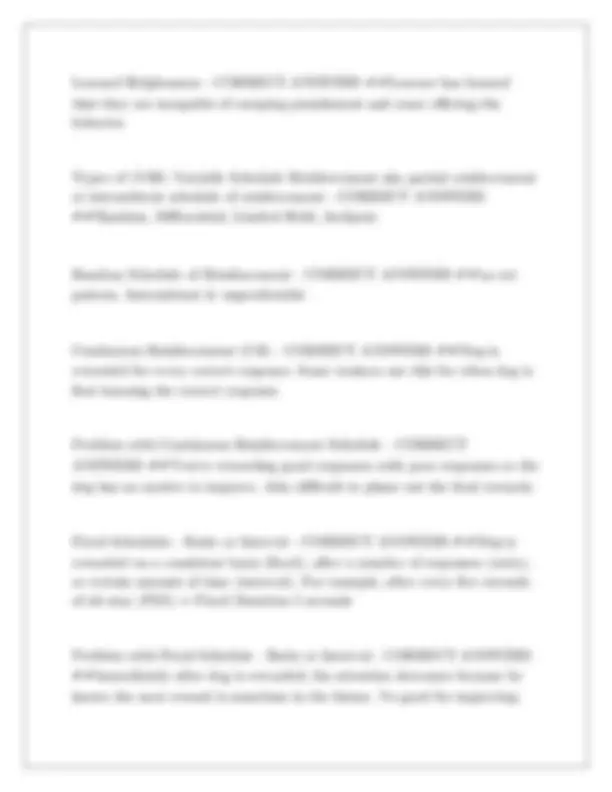
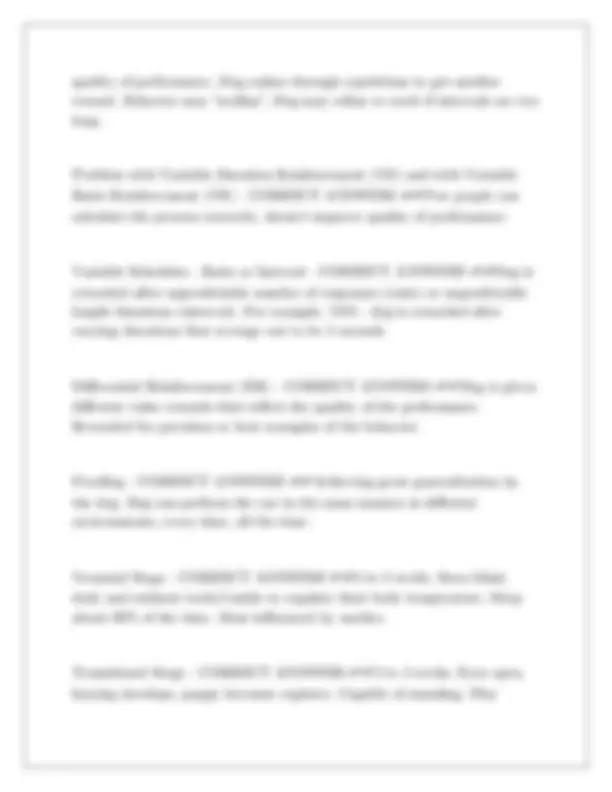
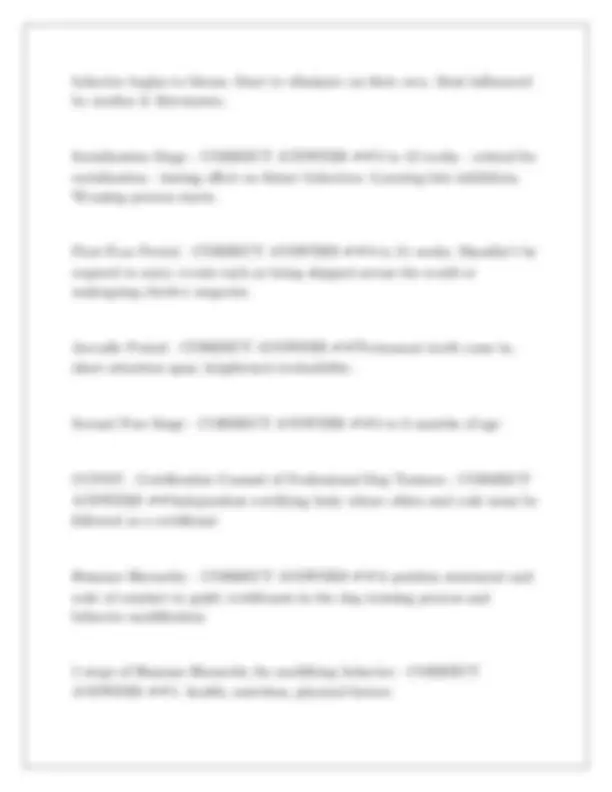
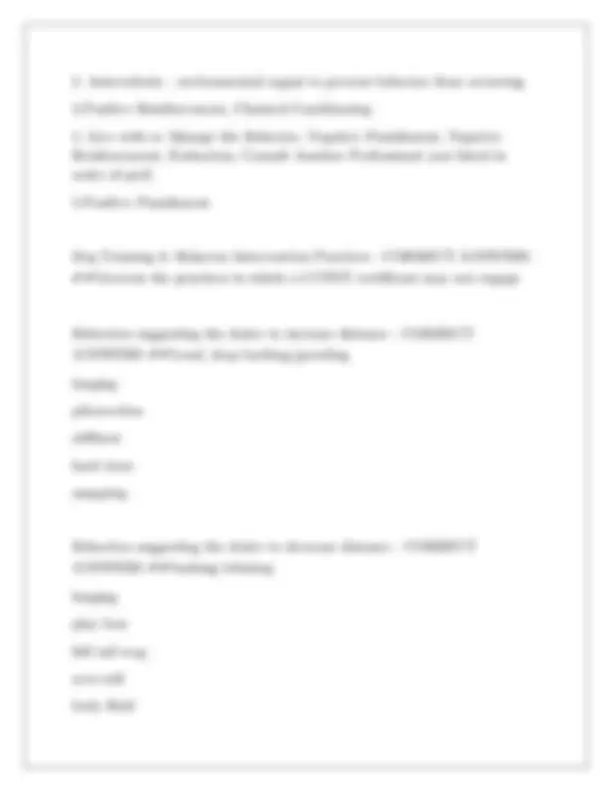
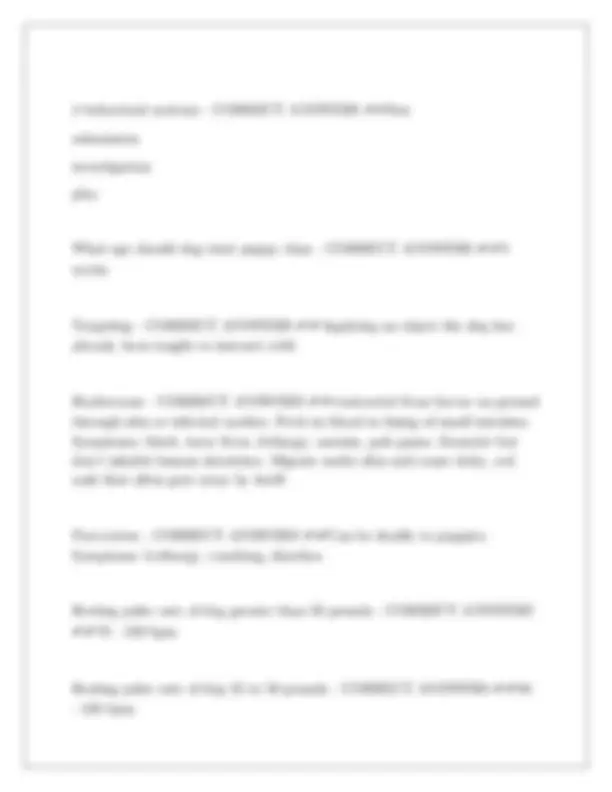
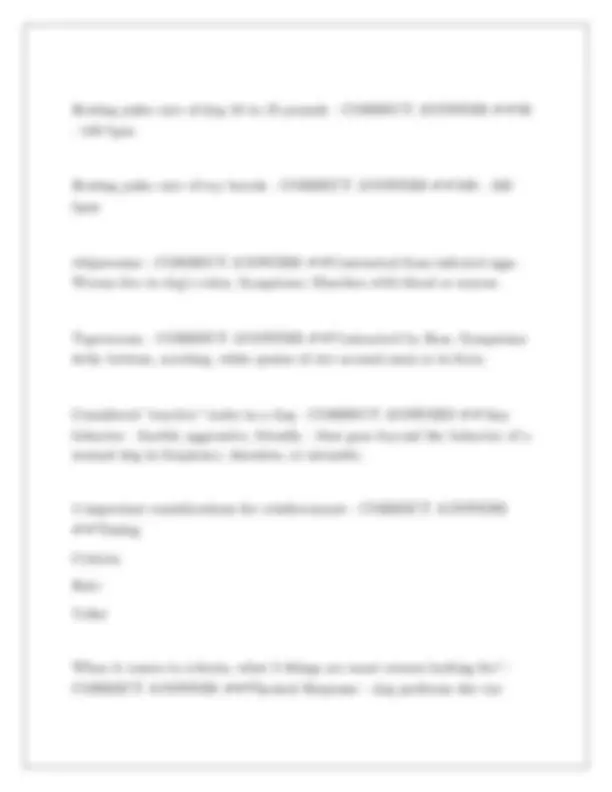
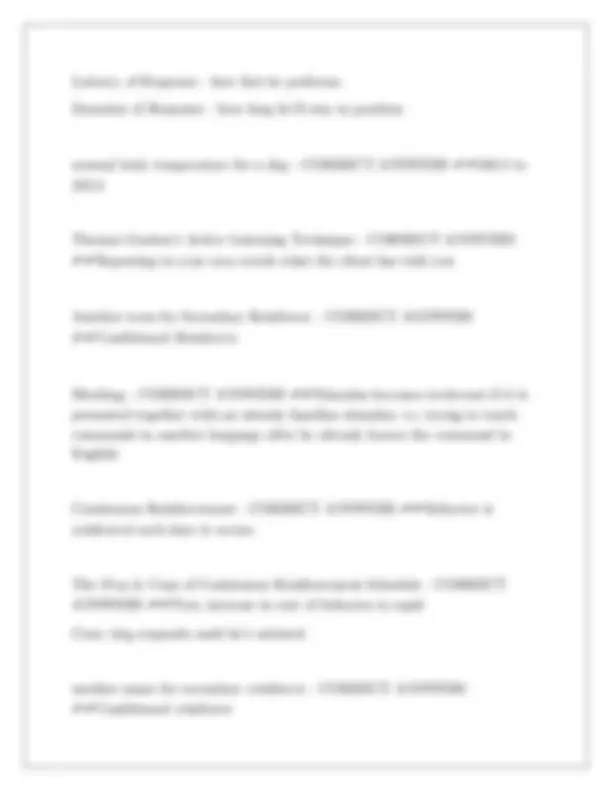
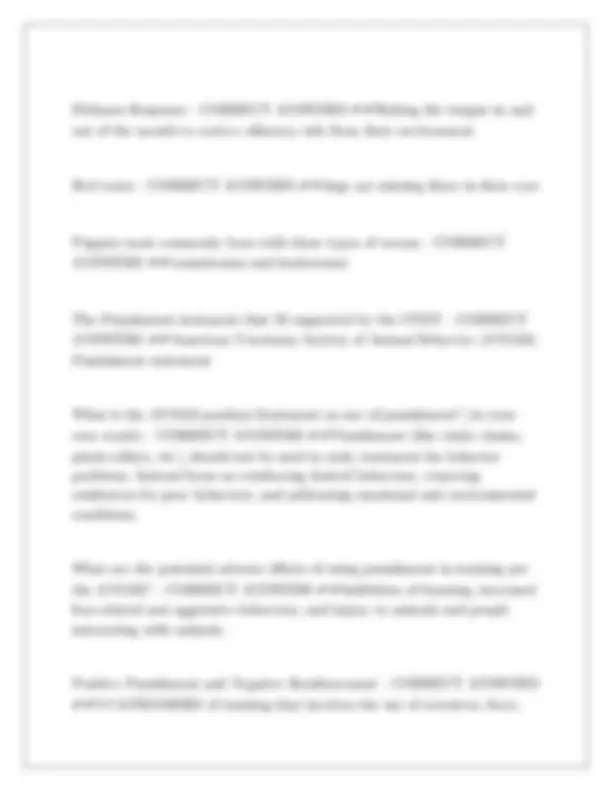
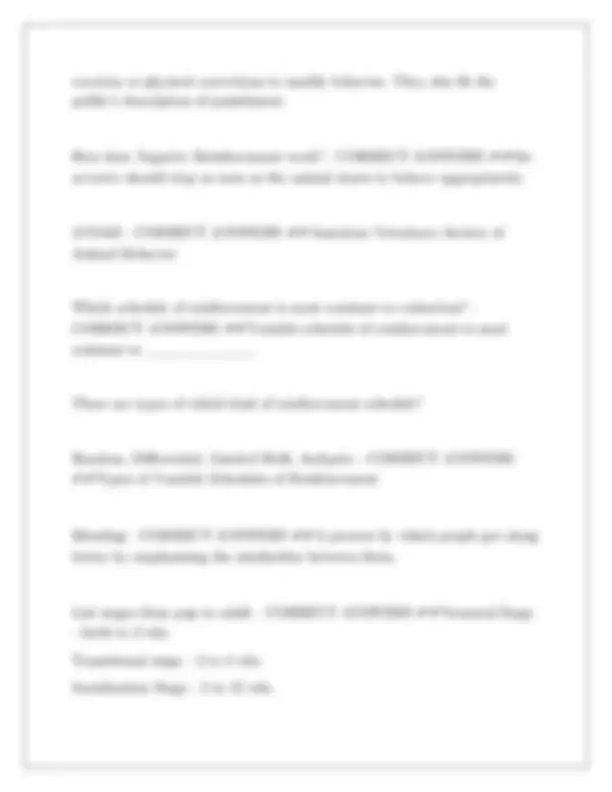



Study with the several resources on Docsity

Earn points by helping other students or get them with a premium plan


Prepare for your exams
Study with the several resources on Docsity

Earn points to download
Earn points by helping other students or get them with a premium plan
Community
Ask the community for help and clear up your study doubts
Discover the best universities in your country according to Docsity users
Free resources
Download our free guides on studying techniques, anxiety management strategies, and thesis advice from Docsity tutors
CPDT-KA exam questions with answers
Typology: Exams
1 / 28

This page cannot be seen from the preview
Don't miss anything!





















Operant Conditioning - Skinner - CORRECT ANSWERS ✔✔learned by association -works with VOLUNTARY behaviors - applying reinforcement or punishment AFTER the behavior Creator of this method considered a "reinforcer" something that made a behavior occur more frequently. If there was no change in the behavior, it wasn't a reinforcement. Formula: Discriminative Stimulus (your command)-Response-Consequence Classical Conditioning - Pavlov - CORRECT ANSWERS ✔✔Learned association between 2 events: 1 event is neutral and 1 event elicits an unconditioned response. Works with INVOLUNTARY/automatic behaviors (like drooling) and placing a neutral sign (like ringing a bell) BEFORE it. Learning - CORRECT ANSWERS ✔✔a change in behavior that lasts for a long time Performance - CORRECT ANSWERS ✔✔the doing of a behavior, doesn't mean that something was learned Discriminative Stimulus - CORRECT ANSWERS ✔✔Your command
Temporary Criteria - CORRECT ANSWERS ✔✔the beginning steps of an exercise towards performing a command that is new to the dog Reward Based Training - CORRECT ANSWERS ✔✔uses positive reinforcement (rewards) and negative punishment (removing something the dog likes - i.e. your attention) Primary Reinforcer - CORRECT ANSWERS ✔✔food, water, anything dog needs for survival. Food activates parasympathetic nervous system, can calm dog, make him less fearful, & result in training process being enjoyable Secondary Reinforcer aka Conditioned Reinforcer - CORRECT ANSWERS ✔✔Clicker, saying "yes",... marks a behavior as rewardable and promises reward in near future. Rewards such as tennis balls, petting, clapping, tug- dog is conditioned to like them. ALL OF THESE ARE LEARNED THROUGH CLASSICAL CONDITIONING. Tertiary Reinforcer - CORRECT ANSWERS ✔✔cues the dog knows and enjoys doing. the doing is the reinforcer One of the most important points about reinforcement - CORRECT ANSWERS ✔✔Do not feed or reinforce unwanted behaviors during training Shaping - CORRECT ANSWERS ✔✔rewards dog for successive approximations of the behavior
Superstitious Behavior - CORRECT ANSWERS ✔✔some irrelevant behavior that the dog performs along with the desired one thinking that it's required to earn the reward. Usually the result of an accidental reinforcement VSR - CORRECT ANSWERS ✔✔Variable Schedules of Reinforcement - for fluency Differential Reinforcement - CORRECT ANSWERS ✔✔A type of VSR where we look for the best examples of the behavior to reward & ignore other offers Limited Hold - CORRECT ANSWERS ✔✔(VSR) Reward is available only for a certain length of time. It rewards the SPEED of response. Operant conditioning - CORRECT ANSWERS ✔✔Majority of dog training is this type Habituation - CORRECT ANSWERS ✔✔A decrease in the strength of a naturally elicited behavior that occurs through repeated presentations of the eliciting stimulus. The reason for varying rewards - CORRECT ANSWERS ✔✔Because dogs can habituate to rewards resulting in slower, less vigorous responses
Sensitization - CORRECT ANSWERS ✔✔reaction to a stimulus becomes even stronger when the stimulus is being shown repeatedly CER Conditioned Emotional Response - CORRECT ANSWERS ✔✔i.e. dog rides in car, hears backfire, now associates ride in car with loud scary noises and doesn't want to ride in cars. Very resistant to extinction Adaptation - CORRECT ANSWERS ✔✔Involves the physical process of training. Sometimes confused with habituation but has nothing to do with learning. It's the tiring of sensory neurons to perceive the stimulus. Learned Irrelevance - CORRECT ANSWERS ✔✔Pre-exposure effect. learns to ignore things that have or had no meaning to him or stops responding to a specific stimulus (cue, trigger) because it doesn't have a particular significance that is relevant to the dog. In more simple words, it's the dynamic that causes your dog to pose deaf ears to your continuous command to "sit", "no bite", or "come". Another example: Dog is crated dog in a group dog class and hears owners cuing their dogs to "come". But this dog is crated and the owner not present or is leading the class. He's basically learned to ignore a "come" command. Owner will probably need to use a new word, like "here" instead. Learned Helplessnes - CORRECT ANSWERS ✔✔Dog gives up, shuts down because he's learned he has no control over the current adverse situation
Elicited behaviors - CORRECT ANSWERS ✔✔prompted by luring or molding (assisted by person to perform) Criteria - CORRECT ANSWERS ✔✔the specific, trainer defined response that is wanted Premack Principle - CORRECT ANSWERS ✔✔a high probability behavior, something the dog loves to do, can be used to reward a low probability behavior (to get "B" the dog must do "A") i.e. dog must "sit" before you'll open the door to let him out. Overshadowing - CORRECT ANSWERS ✔✔when the preferred stimulus (or cue) is not noticed by the animal because there's a more noticeable (to the dog) stimulus around i.e. the hand motion may be more salient (noticeable) to the dog than the verbal cue when both are being used at the same time Permanent Criteria - CORRECT ANSWERS ✔✔the finished product, final goal, fluency Extinction - CORRECT ANSWERS ✔✔occurs when a behavior decreases in frequency or stops happening because of a lack of reinforcement.
Extinction Burst - CORRECT ANSWERS ✔✔increased frequency of a behavior just before extinction. (behavior gets worse, then gets better) Spontaneous Recovery - CORRECT ANSWERS ✔✔sudden recurrence of a learned response during extinction The Humane Hierarchy's steps to manage or modify behavior - CORRECT ANSWERS ✔✔1. Health, Nutrition, and Physical Factors.
Innate behavior - CORRECT ANSWERS ✔✔automatic behavior - i.e. nursing. Dog doesn't have to learn it. What percentage of chromosomes do dogs inherit from each parent - CORRECT ANSWERS ✔✔Dogs inherit half their chromosomes from father and half from the mother Instinctive Drift (Breland Effect) - CORRECT ANSWERS ✔✔Instincts, drives, and fixed action patterns might come back in spite of training Instinct/Drive - CORRECT ANSWERS ✔✔motivation toward self- preservation, reproduction, food acquisition, or defense Critical Period where dog has greatest capacity to learn particular skills and responses - CORRECT ANSWERS ✔✔3 - 16 weeks of age Engrams - CORRECT ANSWERS ✔✔specific neural pathways in the brain that store messages regarding movement/familiar motor actions so they become fluid RAS - Reticular Activating System - CORRECT ANSWERS ✔✔Attention center of brain where activities in world outside are perceived, processed and acted upon. Also "tunes out" what isn't important - learned irrelevance.
Jacobson's Organ - CORRECT ANSWERS ✔✔Vomeronasal - scenting organ located in roof of mouth At what age are dogs capable of breeding? - CORRECT ANSWERS ✔✔as early as 6 months How many times a year does female go into heat and for how long? - CORRECT ANSWERS ✔✔Two times per year for 2 days to 20 days Limbic System and how training affects it. - CORRECT ANSWERS ✔✔Involved with emotions such as fear. When this is active, cerebral cortex is inhibited. We over ride it by giving dog rewards for obeying. Cerebral Cortex - CORRECT ANSWERS ✔✔cognitive functions such as learning & problem solving occur in this part of the brain. Opposition Reflex - CORRECT ANSWERS ✔✔Thigmotaxis - if you pull one way, the dog's natural reflex is to pull the opposite way Social Hierarchy - CORRECT ANSWERS ✔✔Is flexible, affected by variables such as context and physical state of the dog and those around him. Social relationships are established over time by numerous interactions. Dilated Pupils / eyes appear very black - CORRECT ANSWERS ✔✔Eyes appear this way when dog is fearful or defensive
Calming Signals - CORRECT ANSWERS ✔✔yawning, turning away, blinking, averting eyes, etc. produce pacifying effect on animal exhibiting them and possibly the animal they're signaling to. Greeting behavior - CORRECT ANSWERS ✔✔mutual curving nose to tail, somewhat relaxed body and wagging tail. If dog is unsure, body will be stiff and high, wagging slowly Agonistic - CORRECT ANSWERS ✔✔combative Options dogs use to resolve social or competitive disputes - CORRECT ANSWERS ✔✔Avoidance, Appeasement, Submission The main trigger of threats and aggression - CORRECT ANSWERS ✔✔Fear a reaction to a situation, not a personality trait - CORRECT ANSWERS ✔✔Dominance Best neutralizer when you see a dog with conflicted emotions or threatening aggression - CORRECT ANSWERS ✔✔Space. A secondary one is keeping the dog focused on a rewarding task. Social Faciliation - CORRECT ANSWERS ✔✔Pack mentality. i.e. One dog becomes aggressive and others around him follow suit toward a particular dog. One dog gets a drink of water and many others do. etc.
Predatory Drift - CORRECT ANSWERS ✔✔dogs getting along fine and suddenly something causes heightened arousal, triggers limbic response, making one dog regard the other as prey Predatory Behavior - CORRECT ANSWERS ✔✔Directed toward objects moving away - intent is to obtain food - has nothing to do with malice Level 1 Bite - CORRECT ANSWERS ✔✔Air snap - no contact Level 2 Bite - CORRECT ANSWERS ✔✔Skin not punctured, may be red mark or slight bruise Level 3 Bite - CORRECT ANSWERS ✔✔1 to 4 holes from single bite, puncture no deeper than 1/2 length of canine tooth Level 4 Bite - CORRECT ANSWERS ✔✔1to 4 holes from a single bite, deeper than 1/2 length of teeth, severe bruising, could be slashes in both directions Level 5 Bite - CORRECT ANSWERS ✔✔Multiple level 4 bites Level 6 Bite - CORRECT ANSWERS ✔✔Victim dies
Antecedent - CORRECT ANSWERS ✔✔Any stimulus present BEFORE the behavior occurs consequences - CORRECT ANSWERS ✔✔This is what influences/drives the dog's behavior (R+) - CORRECT ANSWERS ✔✔Positive Reinforcement - a reward is added (P-) - CORRECT ANSWERS ✔✔Negative Punishment - a reward is subtracted (P+) - CORRECT ANSWERS ✔✔an aversive is added (R-) - CORRECT ANSWERS ✔✔an aversive is subtracted Aversive - CORRECT ANSWERS ✔✔Punishment, something unpleasant Example of R- - CORRECT ANSWERS ✔✔Dog on slip/choke collar - pressure is released when dog is not pulling Example of P+ - CORRECT ANSWERS ✔✔A punishment is added - dog barks inappropriately and owner whacks him with a newspaper
Definition of P+ and R- - CORRECT ANSWERS ✔✔A punishment is added A punishment or aversive is subtracted Definition of P- and R+ - CORRECT ANSWERS ✔✔Something desirable is subtracted A reward is added Example of P- - CORRECT ANSWERS ✔✔Dog jumping on person. The person turns their back on the dog or leaves the room Example of R+ - CORRECT ANSWERS ✔✔dog performs a sit and is given a treat immediately after performing the behavior. This is 3 to 16 weeks of age - CORRECT ANSWERS ✔✔brain is biologically ready to make long term change in response to social input at this age when to begin vaccination program - CORRECT ANSWERS ✔✔6-8 weeks of age when to start group class with pup - CORRECT ANSWERS ✔✔1 to 2 weeks after receiving their first dose of vaccine for distemper, parvo, and adenovirus
Learned Helplessness - CORRECT ANSWERS ✔✔Learner has learned that they are incapable of escaping punishment and cease offering the behavior Types of (VSR) Variable Schedule Reinforcement aka partial reinforcement or intermittent schedule of reinforcement - CORRECT ANSWERS ✔✔Random, Differential, Limited Hold, Jackpots Random Schedule of Reinforcement - CORRECT ANSWERS ✔✔no set pattern. Intermittent & unpredictable Continuous Reinforcement (CR) - CORRECT ANSWERS ✔✔Dog is rewarded for every correct response. Some trainers use this for when dog is first learning the correct response. Problem with Continuous Reinforcement Schedule - CORRECT ANSWERS ✔✔You're rewarding good responses with poor responses so the dog has no motive to improve. Also difficult to phase out the food rewards. Fixed Schedules - Ratio or Interval - CORRECT ANSWERS ✔✔Dog is rewarded on a consistent basis (fixed), after a number of responses (ratio), or certain amount of time (interval). For example, after every five seconds of sit-stay (FD5) = Fixed Duration 5 seconds Problem with Fixed Schedule - Ratio or Interval - CORRECT ANSWERS ✔✔immediately after dog is rewarded, his attention decreases because he knows the next reward is sometime in the future. No good for improving
quality of performance. Dog rushes through repetitions to get another reward. Behavior may "scallop". Dog may refuse to work if intervals are too long. Problem with Variable Duration Reinforcement (VD) and with Variable Ratio Reinforcement (VR) - CORRECT ANSWERS ✔✔Few people can calculate the process correctly, doesn't improve quality of performance Variable Schedules - Ratio or Interval - CORRECT ANSWERS ✔✔Dog is rewarded after unpredictable number of responses (ratio) or unpredictable length durations (interval). For example, VD5 - dog is rewarded after varying durations that average out to be 5 seconds Differential Reinforcement (DR) - CORRECT ANSWERS ✔✔Dog is given different value rewards that reflect the quality of the performance. Rewarded for precision or best examples of the behavior Proofing - CORRECT ANSWERS ✔✔Achieving great generalization by the dog. Dog can perform the cue in the same manner in different environments, every time, all the time. Neonatal Stage - CORRECT ANSWERS ✔✔0 to 2 weeks. Born blind, deaf, and without teeth.Unable to regulate their body temperature. Sleep about 90% of the time. Most influenced by mother. Transitional Stage - CORRECT ANSWERS ✔✔2 to 4 weeks. Eyes open, hearing develops, puppy becomes explorer. Capable of standing. Play